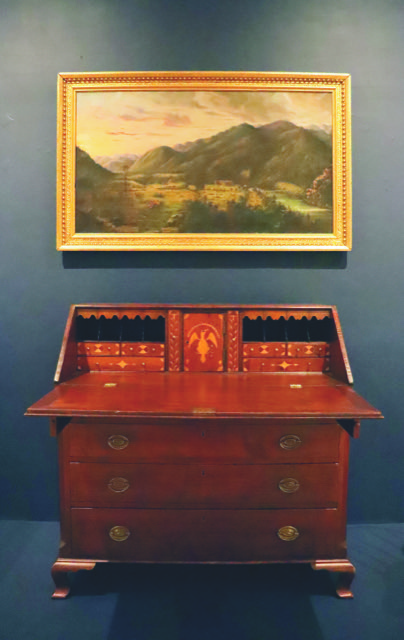

Desk attributed to William McClure, ca. 1803 — 1812, cherry, yellow pine, poplar, and walnut, Greene County. Possibly made for Captain Joseph Kirk by William McClure.
In an 1824 Greene County advertisement, Powhatan Shumak stated that his customers “will be happy with all kinds of cabinet furniture, which shall be made of the best materials, in the most fashionable style, and which for elegance and durability shall not be excelled by any brought from the eastern cities or elsewhere.” During the first half of the 19th century, the number of cabinetmakers known to be working in Greene County increased from two in 1820 to 19 listed in the 1850 census, when occupations were first required to be noted in the federal census.
Shumak took justifiable pride in local cabinet work and was probably including the use of inlay when referring to it as fashionable and elegant. Inlay was a way to add further embellishing details to corner cupboards, desks, and tables and used more often in the furniture of Northeast Tennessee than elsewhere in the region. Local walnut or cherry was usually the primary wood, with some pieces given an extra touch of elegance by a light contrasting wood carved into various shapes and forms and then embedded into the primary wood so that it was flush with the surface ... or inlaid.
Seen here is a detail from a corner cupboard showing a compass point star, a typical Greene County inlay motif that was often paired with a rope and tassel design. The early 19th century fall front desk also shown is made of cherry and has elaborate inlay that includes an eagle as its centerpiece, along with corner fans, strings and leaves. It is attributed to William McClure. Interestingly, he placed the decorative inlay within the desk’s working area so that when closed, none is visible. The inlay on the small walnut sugar chest features a house that resembles those worked into local needlework samplers. Both pieces are in the permanent collection of the Museum of Early Southern Decorative Arts and are on loan to William King Museum of Art. See these and other examples of decorative inlaid furniture, as well as pottery, textiles, metal, and art in “Tennessee Fancy: the Decorative Arts of Northeast Tennessee, 1780-1940,” on view through Oct. 31.
The exhibition is supported by the Massengill-DeFriece Foundation with additional support from The Bank of Tennessee and The Rea Charitable Trust.
WKMA is open Monday through Saturday 10 a.m. to 5 p.m. and Sunday 1-5 p.m. Free admission. Social distancing and masks required.
This is the third in a new series of articles on Tennessee arts and antiques by Betsy K. White, director of William King Museum of Art, Abingdon, Virginia. She is the author of two books on the history of the region’s decorative arts and material culture: “Great Road Style: The Decorative Arts Legacy of Southwest Virginia & Northeast Tennessee” and “Backcountry Makers: An Artisan History of Southwest Virginia and Northeast Tennessee.”